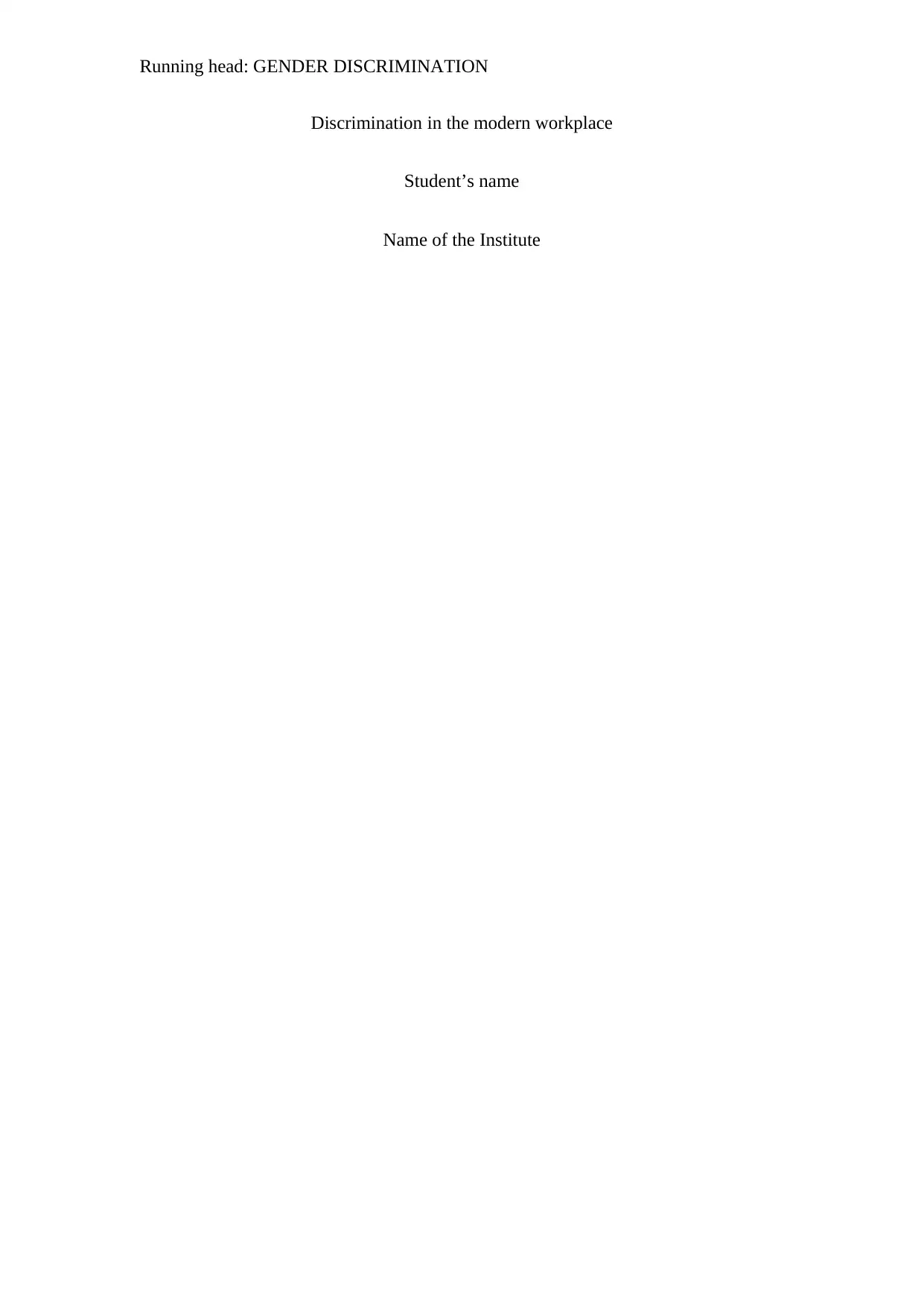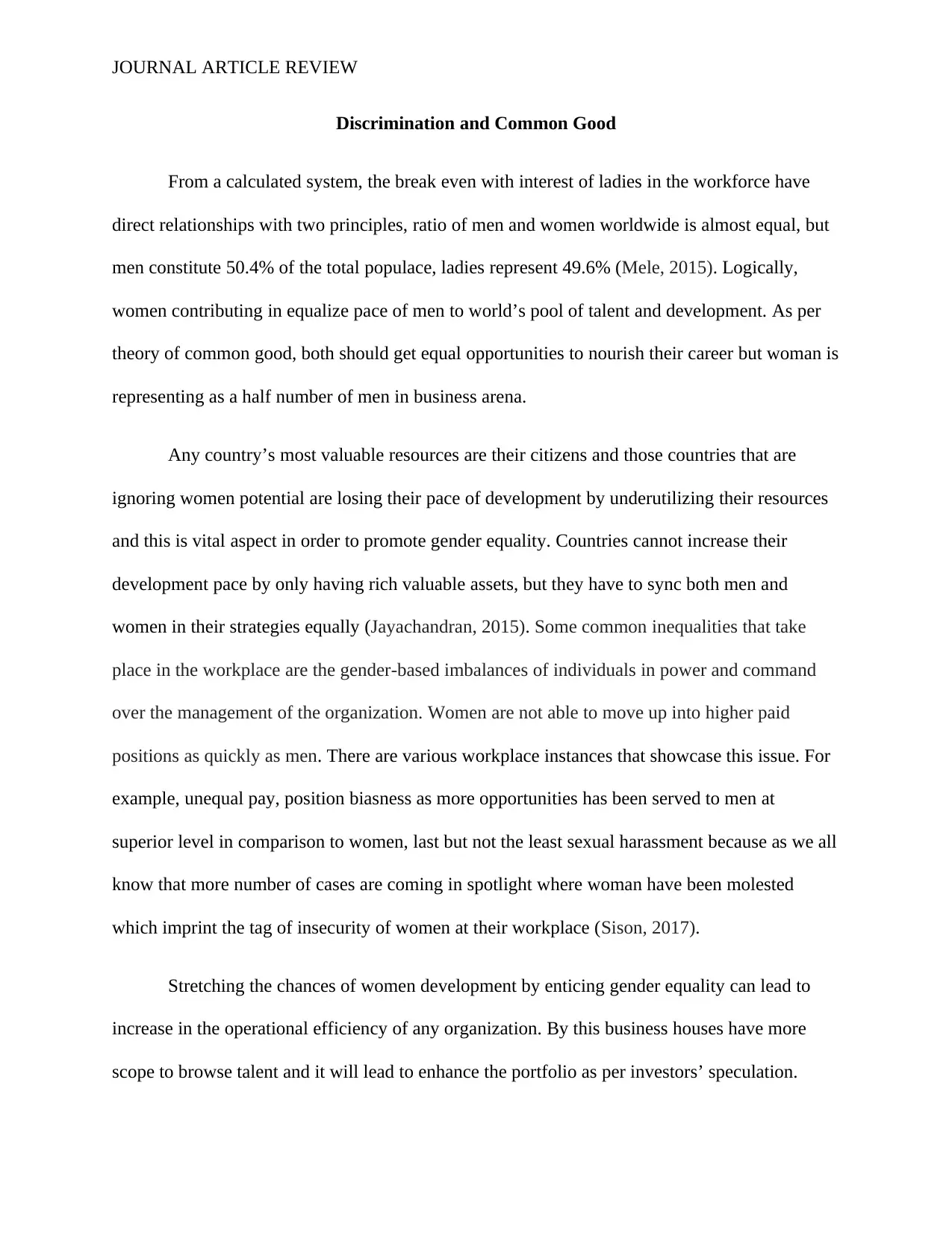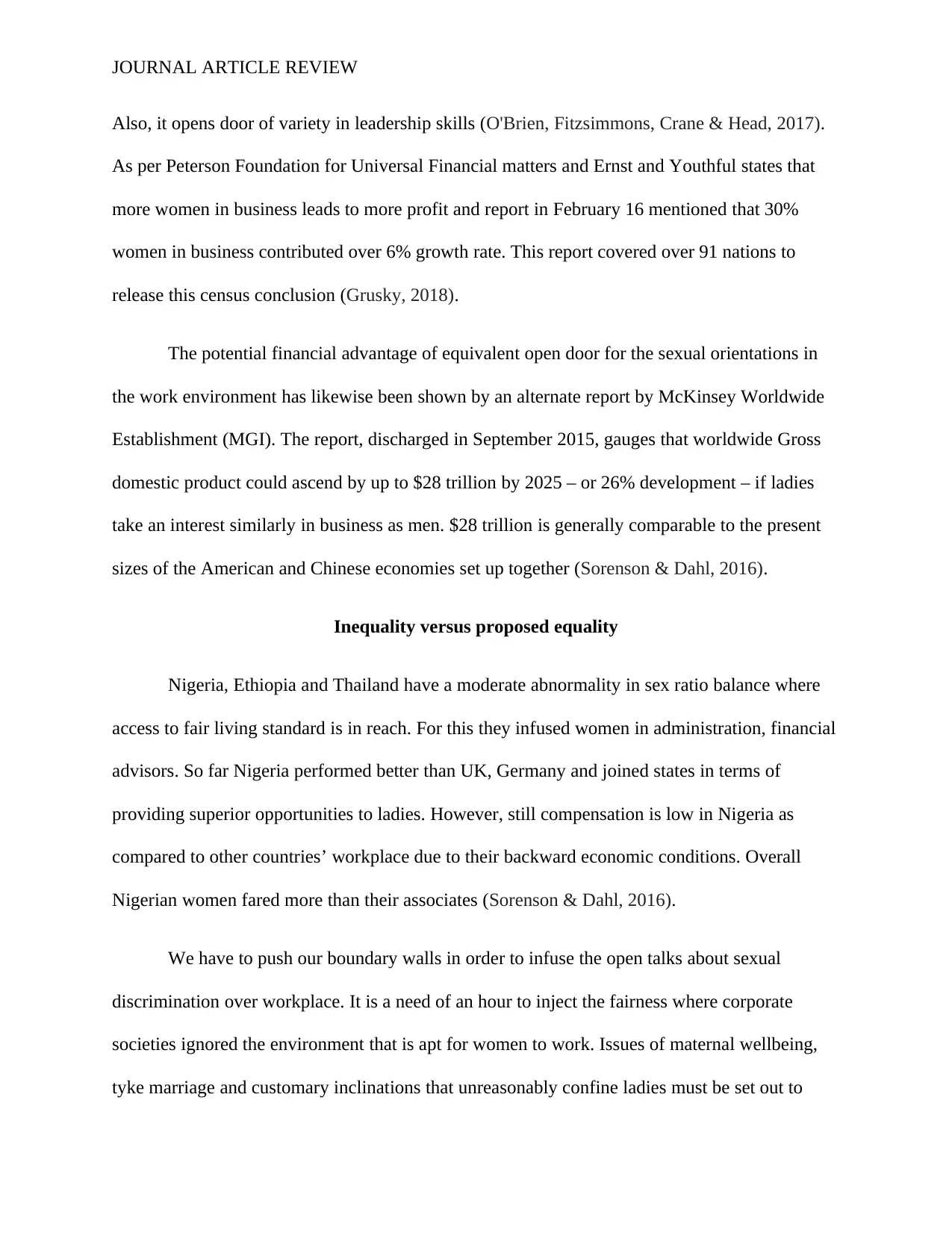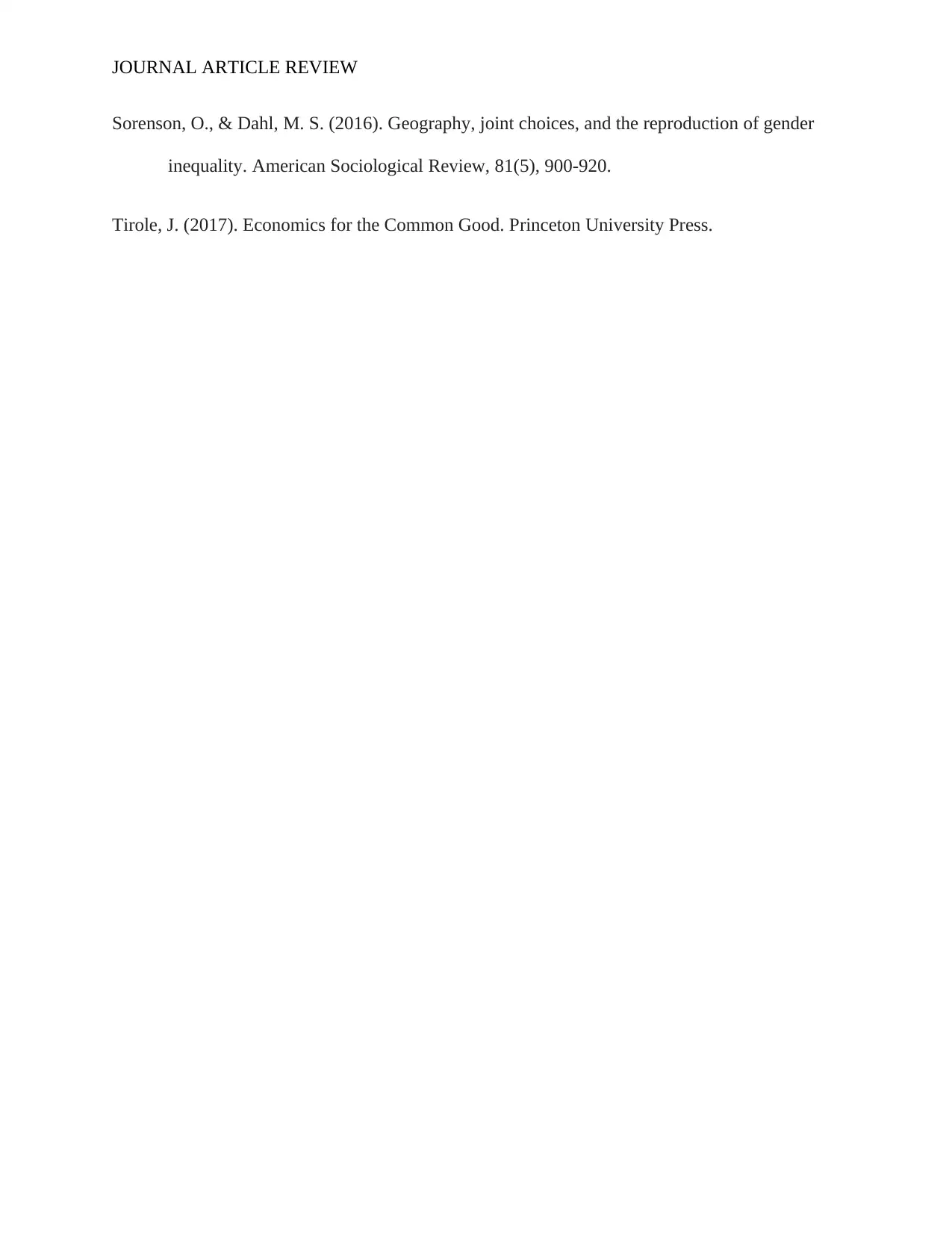Article Review on Gender Discrimination
VerifiedAdded on 2021/06/17
|7
|1676
|100
AI Summary
Contribute Materials
Your contribution can guide someone’s learning journey. Share your
documents today.

Running head: GENDER DISCRIMINATION
Discrimination in the modern workplace
Student’s name
Name of the Institute
Discrimination in the modern workplace
Student’s name
Name of the Institute
Secure Best Marks with AI Grader
Need help grading? Try our AI Grader for instant feedback on your assignments.

JOURNAL ARTICLE REVIEW
Discrimination and Common Good
From a calculated system, the break even with interest of ladies in the workforce have
direct relationships with two principles, ratio of men and women worldwide is almost equal, but
men constitute 50.4% of the total populace, ladies represent 49.6% (Mele, 2015). Logically,
women contributing in equalize pace of men to world’s pool of talent and development. As per
theory of common good, both should get equal opportunities to nourish their career but woman is
representing as a half number of men in business arena.
Any country’s most valuable resources are their citizens and those countries that are
ignoring women potential are losing their pace of development by underutilizing their resources
and this is vital aspect in order to promote gender equality. Countries cannot increase their
development pace by only having rich valuable assets, but they have to sync both men and
women in their strategies equally (Jayachandran, 2015). Some common inequalities that take
place in the workplace are the gender-based imbalances of individuals in power and command
over the management of the organization. Women are not able to move up into higher paid
positions as quickly as men. There are various workplace instances that showcase this issue. For
example, unequal pay, position biasness as more opportunities has been served to men at
superior level in comparison to women, last but not the least sexual harassment because as we all
know that more number of cases are coming in spotlight where woman have been molested
which imprint the tag of insecurity of women at their workplace (Sison, 2017).
Stretching the chances of women development by enticing gender equality can lead to
increase in the operational efficiency of any organization. By this business houses have more
scope to browse talent and it will lead to enhance the portfolio as per investors’ speculation.
Discrimination and Common Good
From a calculated system, the break even with interest of ladies in the workforce have
direct relationships with two principles, ratio of men and women worldwide is almost equal, but
men constitute 50.4% of the total populace, ladies represent 49.6% (Mele, 2015). Logically,
women contributing in equalize pace of men to world’s pool of talent and development. As per
theory of common good, both should get equal opportunities to nourish their career but woman is
representing as a half number of men in business arena.
Any country’s most valuable resources are their citizens and those countries that are
ignoring women potential are losing their pace of development by underutilizing their resources
and this is vital aspect in order to promote gender equality. Countries cannot increase their
development pace by only having rich valuable assets, but they have to sync both men and
women in their strategies equally (Jayachandran, 2015). Some common inequalities that take
place in the workplace are the gender-based imbalances of individuals in power and command
over the management of the organization. Women are not able to move up into higher paid
positions as quickly as men. There are various workplace instances that showcase this issue. For
example, unequal pay, position biasness as more opportunities has been served to men at
superior level in comparison to women, last but not the least sexual harassment because as we all
know that more number of cases are coming in spotlight where woman have been molested
which imprint the tag of insecurity of women at their workplace (Sison, 2017).
Stretching the chances of women development by enticing gender equality can lead to
increase in the operational efficiency of any organization. By this business houses have more
scope to browse talent and it will lead to enhance the portfolio as per investors’ speculation.

JOURNAL ARTICLE REVIEW
Also, it opens door of variety in leadership skills (O'Brien, Fitzsimmons, Crane & Head, 2017).
As per Peterson Foundation for Universal Financial matters and Ernst and Youthful states that
more women in business leads to more profit and report in February 16 mentioned that 30%
women in business contributed over 6% growth rate. This report covered over 91 nations to
release this census conclusion (Grusky, 2018).
The potential financial advantage of equivalent open door for the sexual orientations in
the work environment has likewise been shown by an alternate report by McKinsey Worldwide
Establishment (MGI). The report, discharged in September 2015, gauges that worldwide Gross
domestic product could ascend by up to $28 trillion by 2025 – or 26% development – if ladies
take an interest similarly in business as men. $28 trillion is generally comparable to the present
sizes of the American and Chinese economies set up together (Sorenson & Dahl, 2016).
Inequality versus proposed equality
Nigeria, Ethiopia and Thailand have a moderate abnormality in sex ratio balance where
access to fair living standard is in reach. For this they infused women in administration, financial
advisors. So far Nigeria performed better than UK, Germany and joined states in terms of
providing superior opportunities to ladies. However, still compensation is low in Nigeria as
compared to other countries’ workplace due to their backward economic conditions. Overall
Nigerian women fared more than their associates (Sorenson & Dahl, 2016).
We have to push our boundary walls in order to infuse the open talks about sexual
discrimination over workplace. It is a need of an hour to inject the fairness where corporate
societies ignored the environment that is apt for women to work. Issues of maternal wellbeing,
tyke marriage and customary inclinations that unreasonably confine ladies must be set out to
Also, it opens door of variety in leadership skills (O'Brien, Fitzsimmons, Crane & Head, 2017).
As per Peterson Foundation for Universal Financial matters and Ernst and Youthful states that
more women in business leads to more profit and report in February 16 mentioned that 30%
women in business contributed over 6% growth rate. This report covered over 91 nations to
release this census conclusion (Grusky, 2018).
The potential financial advantage of equivalent open door for the sexual orientations in
the work environment has likewise been shown by an alternate report by McKinsey Worldwide
Establishment (MGI). The report, discharged in September 2015, gauges that worldwide Gross
domestic product could ascend by up to $28 trillion by 2025 – or 26% development – if ladies
take an interest similarly in business as men. $28 trillion is generally comparable to the present
sizes of the American and Chinese economies set up together (Sorenson & Dahl, 2016).
Inequality versus proposed equality
Nigeria, Ethiopia and Thailand have a moderate abnormality in sex ratio balance where
access to fair living standard is in reach. For this they infused women in administration, financial
advisors. So far Nigeria performed better than UK, Germany and joined states in terms of
providing superior opportunities to ladies. However, still compensation is low in Nigeria as
compared to other countries’ workplace due to their backward economic conditions. Overall
Nigerian women fared more than their associates (Sorenson & Dahl, 2016).
We have to push our boundary walls in order to infuse the open talks about sexual
discrimination over workplace. It is a need of an hour to inject the fairness where corporate
societies ignored the environment that is apt for women to work. Issues of maternal wellbeing,
tyke marriage and customary inclinations that unreasonably confine ladies must be set out to

JOURNAL ARTICLE REVIEW
guarantee that each lady can perform at maximum capacity. The Government should frame
policies in order to secure ladies by eliminating sex prejudicial laws and enhancing ladies'
entrance to back (Etzioni, 2014).
It becomes an ethical goal to achieve sex fairness. To attain this government should
attach certain economic benefits with women working conditions and scenarios. If anyone
mention about successful economy than Swiss economy is always popping up at the top of the
mind because of their highly innovation achievement in institutional excellence. But to a closer
look, this economy is starving gender equality on a higher rate. It’s been likely that Swiss women
are more at verge of poverty than men. Core problem to this issue is entrenched traditions. In
fact, until 1985 women in Switzerland cannot open their bank account without their husband’s
permission. And still this inequality exists as women have been forced to dive in stereotypically
women oriented careers like hairdressing or as dental assistants. Likewise, many other
economies are on same page (Tirole, 2017). If we need to erase this gender inequality, then
things have to be executed from school level. For companies they can implement following
strategies in lieu of common good and advocacy to eliminate gender inequality-:
Restructure compensation – In interviews women are likely to mention less salary to
the question “What your salary should be?” because of premonition of society. Instead of
this they should structure fair salary slab and ask them to position within it (Sorenson &
Dahl, 2016).
Reframe training – Infuse gender equality with CST principles at the stage of training
and development only. Youth should be capable of choosing job where they sense the
fairness in opportunity above gender bias.
guarantee that each lady can perform at maximum capacity. The Government should frame
policies in order to secure ladies by eliminating sex prejudicial laws and enhancing ladies'
entrance to back (Etzioni, 2014).
It becomes an ethical goal to achieve sex fairness. To attain this government should
attach certain economic benefits with women working conditions and scenarios. If anyone
mention about successful economy than Swiss economy is always popping up at the top of the
mind because of their highly innovation achievement in institutional excellence. But to a closer
look, this economy is starving gender equality on a higher rate. It’s been likely that Swiss women
are more at verge of poverty than men. Core problem to this issue is entrenched traditions. In
fact, until 1985 women in Switzerland cannot open their bank account without their husband’s
permission. And still this inequality exists as women have been forced to dive in stereotypically
women oriented careers like hairdressing or as dental assistants. Likewise, many other
economies are on same page (Tirole, 2017). If we need to erase this gender inequality, then
things have to be executed from school level. For companies they can implement following
strategies in lieu of common good and advocacy to eliminate gender inequality-:
Restructure compensation – In interviews women are likely to mention less salary to
the question “What your salary should be?” because of premonition of society. Instead of
this they should structure fair salary slab and ask them to position within it (Sorenson &
Dahl, 2016).
Reframe training – Infuse gender equality with CST principles at the stage of training
and development only. Youth should be capable of choosing job where they sense the
fairness in opportunity above gender bias.
Secure Best Marks with AI Grader
Need help grading? Try our AI Grader for instant feedback on your assignments.

JOURNAL ARTICLE REVIEW
Entice work options - Many woman face issues of work life and work mode. Instead of
asking for work as a part time or work from home, promote the solution with wider range
of work band (Blau, 2016).
Unlimited Talent Pool – Companies should enhance gender equality right from the floor
of executives and frame policy of keeping 50-50 ratio of workforce rather than limiting it
to men for seeking talent (Sorenson & Dahl, 2016).
Indulge Networking – Promotes coaching mentoring and guidance with the help of
networking in order to provide more career opportunities to women and help them in
building the confidence (Beham, Drobnic, Prag, Baierl & Eckner, 2018).
Conclusion
Nowadays scenario is changing as youth want the fairness in to their working
environment. They want that talent should be serve over gender bias and wants to experience
healthy work life balance. If gender equality would be absent from organization ambience then it
would not lead to healthy working environment. This is representing the bigger opportunity for
recreating gender goals. Moreover, this challenge is not only present in workplace but also
address to sectors like politics, research, education and to name a few. So, to erase this taboo,
every aspect of this society has to work on it and put society benefits at upfront regardless of
personal gains. With inequality there is a disobedient attitude towards common good as by this
fairness is being restrained for almost half of the population over the globe. It has been already
mentioned that without community engagement this gender inequality cannot be demolished.
System has to be changed by root that is from the school level only.
Entice work options - Many woman face issues of work life and work mode. Instead of
asking for work as a part time or work from home, promote the solution with wider range
of work band (Blau, 2016).
Unlimited Talent Pool – Companies should enhance gender equality right from the floor
of executives and frame policy of keeping 50-50 ratio of workforce rather than limiting it
to men for seeking talent (Sorenson & Dahl, 2016).
Indulge Networking – Promotes coaching mentoring and guidance with the help of
networking in order to provide more career opportunities to women and help them in
building the confidence (Beham, Drobnic, Prag, Baierl & Eckner, 2018).
Conclusion
Nowadays scenario is changing as youth want the fairness in to their working
environment. They want that talent should be serve over gender bias and wants to experience
healthy work life balance. If gender equality would be absent from organization ambience then it
would not lead to healthy working environment. This is representing the bigger opportunity for
recreating gender goals. Moreover, this challenge is not only present in workplace but also
address to sectors like politics, research, education and to name a few. So, to erase this taboo,
every aspect of this society has to work on it and put society benefits at upfront regardless of
personal gains. With inequality there is a disobedient attitude towards common good as by this
fairness is being restrained for almost half of the population over the globe. It has been already
mentioned that without community engagement this gender inequality cannot be demolished.
System has to be changed by root that is from the school level only.

JOURNAL ARTICLE REVIEW
References
Beham, B., Drobnic, S., Prag, P., Baierl, A., & Eckner, J. (2018). Part-Time Work And Gender
Inequality In Europe. A Comparative Analysis Of Satisfaction With Work–Life Balance.
Blau, F. D. (2016). Gender, inequality, and wages. OUP Catalogue.
Etzioni, A. (2014). Common good. John Wiley & Sons, Ltd.
Grusky, D. (2018). The inequality reader: Contemporary and foundational readings in race, class,
and gender. Routledge.
Jayachandran, S. (2015). The roots of gender inequality in developing
countries. economics, 7(1), 63-88.
Mele, D. (2015). Virtues, values, and principles in Catholic social teaching. In Handbook of
Virtue Ethics in Business and Management (pp. 1-13). Springer Netherlands.
O'Brien, K., Fitzsimmons, T. W., Crane, M., & Head, B. (2017). Workplace gender inequality as
a Wicked Problem: Implications for research and practice. In Academy of Management
Proceedings (Vol. 2017, No. 1, p. 14717). Briarcliff Manor, NY 10510: Academy of
Management.
Sison, A. J. G. (2017). Free Markets with Solidarity & Sustainability: Facing the Challenge,
edited by Martin Schlag and Juan A. Mercado. Washington, DC: The Catholic University
of America Press, 2016. 313 pp. ISBN: 9780813228433. Business Ethics
Quarterly, 27(2), 327-330.
References
Beham, B., Drobnic, S., Prag, P., Baierl, A., & Eckner, J. (2018). Part-Time Work And Gender
Inequality In Europe. A Comparative Analysis Of Satisfaction With Work–Life Balance.
Blau, F. D. (2016). Gender, inequality, and wages. OUP Catalogue.
Etzioni, A. (2014). Common good. John Wiley & Sons, Ltd.
Grusky, D. (2018). The inequality reader: Contemporary and foundational readings in race, class,
and gender. Routledge.
Jayachandran, S. (2015). The roots of gender inequality in developing
countries. economics, 7(1), 63-88.
Mele, D. (2015). Virtues, values, and principles in Catholic social teaching. In Handbook of
Virtue Ethics in Business and Management (pp. 1-13). Springer Netherlands.
O'Brien, K., Fitzsimmons, T. W., Crane, M., & Head, B. (2017). Workplace gender inequality as
a Wicked Problem: Implications for research and practice. In Academy of Management
Proceedings (Vol. 2017, No. 1, p. 14717). Briarcliff Manor, NY 10510: Academy of
Management.
Sison, A. J. G. (2017). Free Markets with Solidarity & Sustainability: Facing the Challenge,
edited by Martin Schlag and Juan A. Mercado. Washington, DC: The Catholic University
of America Press, 2016. 313 pp. ISBN: 9780813228433. Business Ethics
Quarterly, 27(2), 327-330.

JOURNAL ARTICLE REVIEW
Sorenson, O., & Dahl, M. S. (2016). Geography, joint choices, and the reproduction of gender
inequality. American Sociological Review, 81(5), 900-920.
Tirole, J. (2017). Economics for the Common Good. Princeton University Press.
Sorenson, O., & Dahl, M. S. (2016). Geography, joint choices, and the reproduction of gender
inequality. American Sociological Review, 81(5), 900-920.
Tirole, J. (2017). Economics for the Common Good. Princeton University Press.
1 out of 7
Related Documents
Your All-in-One AI-Powered Toolkit for Academic Success.
+13062052269
info@desklib.com
Available 24*7 on WhatsApp / Email
![[object Object]](/_next/static/media/star-bottom.7253800d.svg)
Unlock your academic potential
© 2024 | Zucol Services PVT LTD | All rights reserved.





